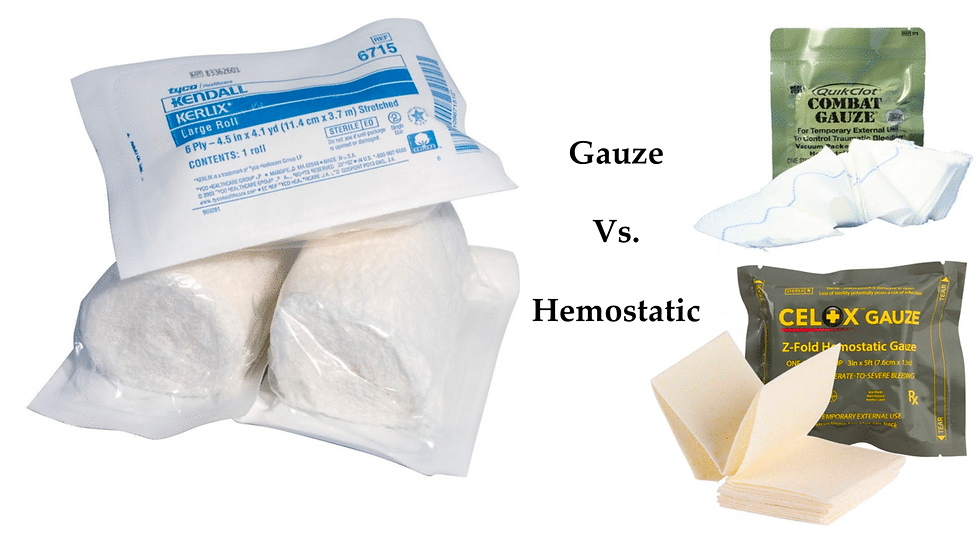Gauze or Hemostatic Dressing?
- James Cameron

- Jan 3, 2021
- 3 min read

In this day and age, we need to broaden our knowledge and requirements for proper medical supplies. Medical suppliers put together kits that they claim are the minimum required equipment for proper individual first aid kits. As the general public, end user and buyer we need to remember they are selling with the aim to make a profit.
Having been a first responder to multiple mass casualty situations I have seen that techniques can trump equipment. If you don’t have a CAT tourniquet do we just throw our hands up and let the victim die of exsanguination? I would hope not. If we understand how a tourniquet works then we can use other techniques with other materials to accomplish the task of stopping the bleed.
This brings me to my question. What is better a roll of regular gauze, gauze impregnated with a hemostatic agent or granular hemostatic agents to stop the bleed? If we understand that what ultimately stops the bleed is pressure, then I would argue that a roll of gauze is just as effective as a hemostatic dressing. Again, I have used both on real wounded casualties and personally a roll of gauze is easier to use and just as effective.
It would appear my observation has also been the subject of studies done by various groups of medical doctors. According to the “Comparison of Celox-A, ChitoFlex, WoundStat, and Combat Gauze Hemostatic Agents Versus Standard Gauze Dressing in Control of Hemorrhage in a Swine Model of Penetrating Trauma” written by Lanny F. Littlejohn, MD, John J. Devlin, MD, Sara S. Kircher, Robert Lueken, MD, Michael R. Melia, MD, and Andrew S. Johnson, MD
Standard gauze dressing was as efficacious as Celox-A, Chitoflex, and combat gauze in treating uncontrolled hemorrhage from small penetrating wounds not ame- nable to tourniquet placement. The present findings also suggest that the form factor of poured granules may not be as effective as tube-delivered hemostatic granules or gauze products
Although great advances have been made as it pertains to hemostatic agents there are also multiple side effects and detractors that need to be addressed and considered.
According to published data gained from both animal studies and case reports the thermal injury and burns resulting from the exothermic reaction and the poor biodegradability are the main challenges for QuikClot. However, although it is claimed that the use of QuikClot ACS+, unlike the previous generation, does not cause thermal injury, there are currently no large-scale clinical reports regarding the occurrence of such a complication after the application of the QuikClot ACS+ on the wound.
It is worrisome that all the hemostatic agents composed of granules can leave residue in the interior of the blood vessels. In addition, all of these agents may obstruct arterial flow. Those hemostats that activate the clotting pathway can also cause distal thrombosis.
Significant blood loss leads to hypothermia and hemostatic agents have can fail if and when the patient is experiencing hypothermia
Cost, a basic single bandage of a hemostatic agents generally starts at $40 however a roll of gauze starts at $1
It should be noted that any of the above-mentioned agents can fail if applied incorrectly; therefore, appropriate training is the key to minimizing this risk.
In summary QuickClot and other hemostatic dressings look and sound sexy, but what real advantages to they provide? I am not saying that hemostatic agents do not work, rather I am saying understanding how they work and their side effects should be considered.
When I speak to clients regarding their emergency medical needs I explain that I would rather put their money towards increasing additional medical supplies and getting more bang for the buck. Here are my recommendations for an effective individual first aid kit (trauma) that could be purchased for around $30.
SWAT-T Tourniquet ($10)
4” roll of gauze ($1)
Pressure bandage -Israeli type ($6)
Nitrile gloves ($1)
Chest Seal (optional) $10)
An argument of SWAT-T verse CAT tourniquets could also be made however SWAT-T is multifunctional and is $10 verses the single purpose $30 CAT. (I understand the stance of what a life is worth however the honest truth is we all need to be budget conscious especially when you deal in volume to add hundreds of medical kits for large organizations)
References:
https://onlinelibrary.wiley.com/doi/pdf/10.1111/j.1553-2712.2011.01036.x
https://www.bleedingcontrol.org/~/media/bleedingcontrol/files/compendiumhemorrhagecontrol.ash
https://www.ncbi.nlm.nih.gov/pmc/articles/PMC4869418/




Comments